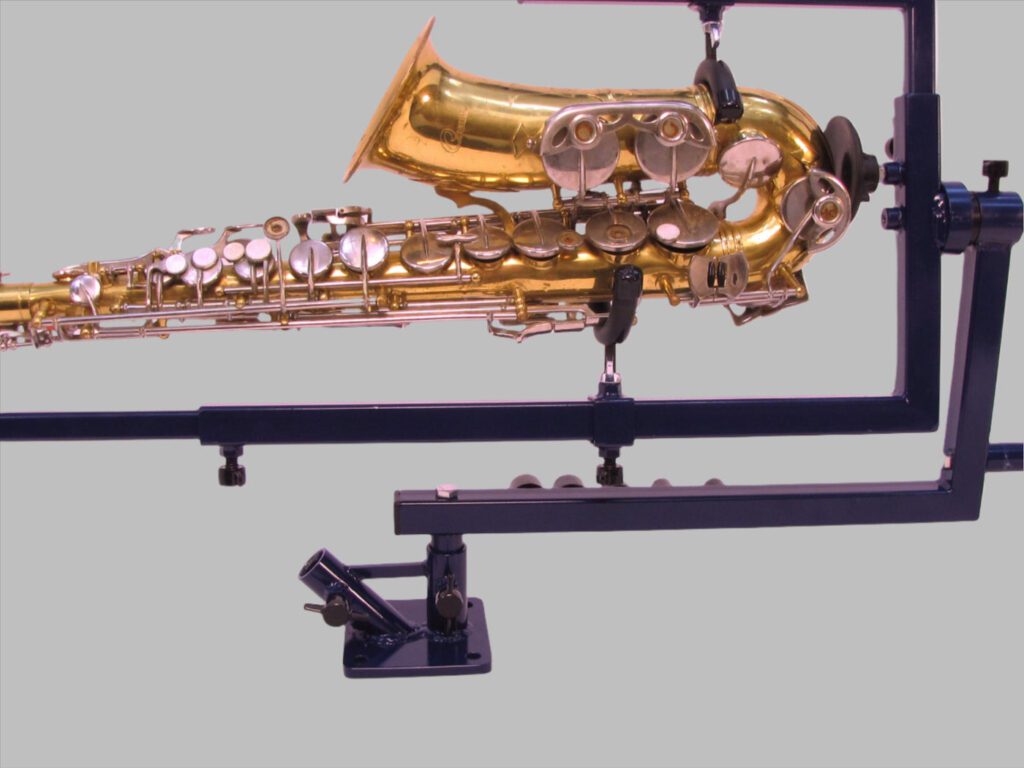Saxophone Hub
Best Tools for Saxophone Repairs at Home: Essentials for Basic Maintenance and Minor Repairs

Introduction
For saxophonists, having a basic toolkit at home can be invaluable for handling minor repairs and performing regular maintenance. With the right tools, you can manage simple issues such as sticky pads, loose screws, and regular cleaning, ensuring your saxophone stays in top condition. However, it’s important to know when to handle issues yourself and when to seek professional help. In this guide, we’ll cover essential tools every saxophone player should consider and offer tips for safely performing minor repairs at home.
Why Every Saxophone Player Should Have Basic Repair Tools
Having basic saxophone repair tools on hand can save time, reduce the need for frequent professional visits, and help saxophonists keep their instruments in good shape. Whether it’s cleaning out moisture, tightening a loose screw, or lubricating keys, these small fixes can improve your playing experience and keep your saxophone responsive. However, it’s essential to understand the limits of DIY repairs. For complex repairs or significant adjustments, professional service is recommended to avoid accidental damage.
Essential Tools for Cleaning and Maintenance
Routine cleaning is a critical part of saxophone maintenance that prevents the buildup of dirt and moisture. Here are some essential tools for keeping your saxophone clean:
Cleaning Swabs and Brushes
Swabs and brushes are key for removing moisture and debris from the saxophone body, neck, and mouthpiece:
- Body Swab: Use a soft, absorbent swab designed for saxophones to remove moisture from the interior, especially after each playing session.
- Small Brushes: Brushes help reach difficult areas within the neck and mouthpiece, preventing bacteria buildup and ensuring a clear tone.
Regular swabbing prevents corrosion and protects the pads, keeping your saxophone in better condition for longer.
Microfiber Cloths
Microfiber cloths are essential for cleaning the saxophone’s exterior without scratching the finish. After each use, wipe down the body, keys, and bell to remove fingerprints, oils, and dust. Using a high-quality microfiber cloth prevents damage to the saxophone’s surface and keeps it looking polished.
Pad Cleaning Paper
Sticky pads are a common issue caused by moisture and residue. Pad cleaning paper is an effective way to address this:
- Place the cleaning paper under the sticky pad.
- Press the key down gently to absorb moisture and dirt.
- Remove the paper and repeat as needed.
Using pad paper regularly helps prevent stickiness, making keys more responsive and easy to play.
Tools for Minor Key Adjustments and Pad Care
Keys and pads are essential for producing clear tones and accurate notes. Having the right tools can help with minor adjustments, ensuring smooth key action and responsive pads.
Small Screwdriver Set
A small screwdriver set is essential for adjusting and tightening loose key screws. Here’s how to use it safely:
- Select the Right Size: Choose a screwdriver that fits the screw to avoid stripping.
- Tighten Carefully: Gently turn the screwdriver to avoid over-tightening, which can damage the screws or key alignment.
This tool is useful for minor adjustments, but be cautious with any further repairs to avoid impacting key balance.
Pad Saver or Pad Dryer
Pad savers are designed to help reduce moisture retention in pads, which can prevent sticky keys and prolong pad life:
- Insert After Playing: Place the pad saver inside the saxophone body to absorb excess moisture after playing.
- Regular Use: Using a pad saver regularly helps protect your pads, making them last longer and keeping them dry.
This tool is especially useful in humid climates where moisture is a frequent issue.
Synthetic Key Oil
Key oil is necessary for maintaining smooth key action. Proper lubrication prevents stiffness and keeps keys responsive:
- Use Sparingly: Apply only a drop or two at key pivot points. Avoid over-oiling, as excess can attract dirt.
- Wipe Away Excess: After applying, use a cloth to remove any excess oil to prevent build-up.
Regular lubrication keeps the keys functioning smoothly, enhancing the overall playability of the saxophone.
Tools for Cork and Spring Maintenance
Neck corks and springs are essential for keeping the saxophone intact and responsive. Having a few simple tools can help address minor issues with these components.
Cork Grease
Cork grease is necessary to maintain the neck cork, ensuring a secure fit between the neck and mouthpiece:
- Apply Sparingly: Rub a small amount of grease onto the neck cork, enough to make it smooth but not slippery.
- Use as Needed: Apply grease every few weeks or whenever the cork feels dry.
Regular use of cork grease helps prevent cracking and keeps the cork in good condition, making assembly easier.
Spring Hook Tool
A spring hook is useful for adjusting loose or misaligned springs, which can affect key action:
- Locate the Spring: Find the spring that needs adjustment and gently hook it.
- Reposition with Care: Adjust the spring position slowly to avoid bending or breaking it.
This tool allows for careful spring adjustment, but it’s best used only for minor corrections. Major spring issues are better handled by professionals.
Needle Nose Pliers
Needle nose pliers are versatile for making small adjustments to springs or keys:
- Use Gently: Only apply light pressure to avoid bending delicate parts.
- Perfect for Adjustments: Useful for adjusting springs or straightening minor misalignments.
Be cautious with pliers, as too much pressure can cause lasting damage to sensitive parts. When in doubt, consult a professional for significant adjustments.
Important Safety Tips for At-Home Repairs
While at-home repairs can be convenient, saxophone parts are delicate, and improper handling can lead to costly damage. Here are some essential safety tips for DIY saxophone maintenance:
- Avoid Over-Tightening: When adjusting screws or keys, turn gently and stop if you feel resistance. Over-tightening can damage the screws or alter the instrument’s alignment.
- Use the Right Tools: Always use tools designed for saxophone maintenance, as household tools may not be suitable and can damage the instrument.
- Handle Springs Carefully: Springs are sensitive and can snap if bent too far. Make minor adjustments only and consider professional assistance for major spring repairs.
- When in Doubt, Consult a Professional: For complex repairs or adjustments, it’s best to rely on a professional to ensure precision and avoid potential damage.
Practicing caution with at-home repairs can extend the life of your saxophone and prevent accidental damage.
Conclusion
Having the right tools for basic saxophone maintenance can help you keep your instrument in good condition and address minor issues with ease. From cleaning tools like swabs and pad paper to essential items like cork grease and key oil, each tool plays an important role in preserving your saxophone’s performance and lifespan. However, knowing your limits with DIY repairs is crucial, and for more complex repairs, professional services are highly recommended.
For saxophonists in Nigeria and Ghana, our expert repair service offers comprehensive solutions for saxophone maintenance, adjustments, and repairs. With a satisfaction guarantee, free consultations, and a discount for first-time clients, we’re here to keep your saxophone at its best. Contact us on WhatsApp at +234-813-540-4292 or follow us on social media at Horns Engineer aka Hornsify for more tips on saxophone care and repair.
Frequently Asked Questions (FAQs)
1. Can I fix sticky saxophone pads at home?
Yes, sticky pads can often be resolved by using pad cleaning paper to absorb moisture and residue. Place the paper under the pad, press gently, and pull it out slowly. For persistent stickiness, it may be best to consult a professional.
2. What kind of oil should I use for saxophone keys?
Use a high-quality synthetic key oil specifically designed for musical instruments. Avoid household oils, as they can attract dust and may damage the metal components over time.
3. How often should I use cork grease on my saxophone?
Apply cork grease every few weeks or when the cork feels dry or tight. Regular use helps maintain the cork’s flexibility and prevents cracking, making it easier to fit the neck and mouthpiece.
4. Can I use regular household tools for saxophone repairs?
It’s not recommended to use household tools for saxophone repairs, as they may not fit properly and could damage delicate parts. Investing in a small screwdriver set, spring hook tool, and needle nose pliers specifically for saxophone maintenance is best.
5. When should I consult a professional for saxophone repairs?
If you encounter issues like severe key misalignment, broken springs, or persistent pad stickiness that cannot be resolved with basic tools, it’s best to consult a professional. Complex repairs require expertise to ensure the saxophone remains in optimal condition.



